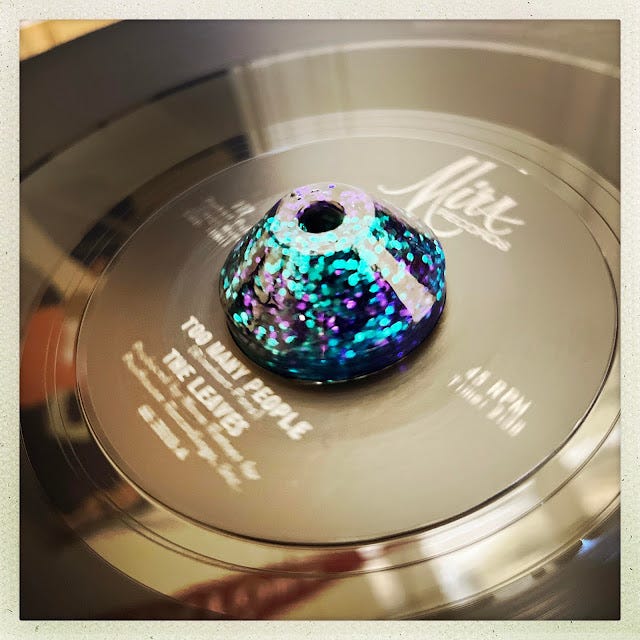There’s a short list of songs that have never lost their urgency for me. Near the top is “Too Many People” written by Bill Rinehart and Jim Pons, released as the Leaves’ debut single on Mira in July of 1965. (It was reissued a year later, and rerecorded for their first album.) Though the band is best known for their trippy streak through “Hey Joe,” a song later recorded by Jimi Hendrix, they occupy a permanent place in my heart for the disdainful, extremely rocking “Too Many People.”
Drop the needle: the song sounds pissed off about something right from the start, the complaint issuing from a bent harmonica phrase played by John Beck. The full band—Pons on bass, Rinehart on lead guitar, Robert Lee Reiner on rhythm, Tom Ray on drums; Beck adds tambourine—arrives impatiently moments later. The opening bars feel uncomfortable, too, an angry, churning blend of loud guitars playing rudimentary, obsessive A and G chords, Ray’s stubborn snare emphasizing the backbeat, Beck’s aggressive tambourine winding through it all. Five bars in, a cool, heavy-lidded gang vocal enters repeating the title phrase, stretching the last over two-plus bars, the deep sigh of an offended adolescent. If the band had decided to sing only the title phrase, turning the song into a quasi-instrumental, its loud complaints would still be well-taken, so tightly wound up is the arrangement, the sound of someone outgrowing their hand-me-downs, busting at the seams.
Then Pons sings—demands, really—the first line:
Too many people are trying to change me
Too many people are looking to rearrange me
and the grievances come into sharp focus, the sullen, teen-in-a-bedroom title phrase morphing into genuine outrage with a complex world—at chafing limitations, expectations, the plummeting ceiling of possibilities that a young person faces. Like an escapee, the song insistently darts forward—from the opening harmonica scowl to the churning rhythms to the sung title phrases to the pointed vocal—reaching its peak in the intense 12-bar middle, where Pons climbs onto his poor-man’s soapbox and snarls an anti-litany. “But the last thing I'll ever do to prove that I’m a man like you,” he promises, as Rinehart goads him on the guitar,
is to work from nine to five trying to keep myself alive
and have to listen everyday to everybody’s jive
and concentrate my time on simply trying to make a dime
and agitate my mind on trying to make our values rhyme
At the menacing chord change to D (“But the last thing...”), the song stands up straight and balls its fists, serious now, Pons singing as if the words were coming to him at the moment, so rawly authentic is the performance. The passage is incendiary, demanding to be heard, impossible to ignore. And now the agitated arrangement, the indignant guitars, Beck’s excitable tambourine make sense: the song was waiting for Pons to translate a voiceless, angry mood into something vivid and precise, and nameable. “Protest songs” were in the air—and his vocal is among the greatest and most evocative of the era, a hair-raising, pulse-quickening howl from suburban Los Angeles. The fangs still show nearly sixty years down the line.
Second verse, same as the first: too many things, the oppressions mounting, stuff he’s got to do—fill in the blanks here with draft board, work, school, hair cut, church, fate, whatever's plaguing you today—, the bags he’s gotta run through pushing him to the edge. And the last thing he’ll ever do, he promises again, is worry (“because that’s what everybody else does”) or wear a suit and tie, “when I’d rather sit and die.” There are implied exclamation points at the end of every phrase Pons barks. A frantic 12-string guitar solo leads to the inevitable vision of people doubling and tripling as the song fades.
Adolescent stuff, yeah, and no less poignant and eternal for that. Pons’s utter conviction lifts the song from teen angst to something meaner, more grown-up, threatening, even. The writer Bobbie Ann Mason has said that “Rock and roll is about desire, about wanting something better,” adding, “My understanding of the rock and roll dream is that a kid in an isolated place or a small town or an underprivileged world could transcend it somehow.” The kid raising a voice and taking a stand in “Too Many People” is a silhouette, and we all fit into the outline at some time or another during our lives, the frustrations taking different sizes and weights over time but originating in the same lousy place. The magic in “Too Many People” sparks down the generations, lifting the song from its origin point. Its values rhyme with ours, to borrow a phrase.
There are a handful of rock and roll songs that I’d run through a wall for—Johnny Thunder’s “I’m Alive,” Rod Stewart’s “(I Know) I'm Losing You,” the Buzzcocks’ “What Do I Get,” the Ramones’ “I Just Want To Have Something To Do,” Charlie Pickett and the Eggs’ live version of the Flamin’ Groovies’ “Shake Some Action.” Countless spins later, I find “Too Many People” as rawly exciting and profoundly moving as I did the first time I heard it, decades ago on the essential Rhino Nuggets compilation. Unruly vibes were moving in a million directions at once in ‘65. James Osterberg was in Ann Arbor, Michigan drumming and cussing in the Iguanas when “Too Many People” was unleashed, a couple years away from assembling from used auto parts the Psychedelic Stooges with Dave Alexander and the Asheton brothers. The line from sunny LA to gray Detroit is ragged, the line is there.
Dig the Leaves on local TV in 1966. Even miming the tune they threaten to bring the house down, grins, guffaws and all.




